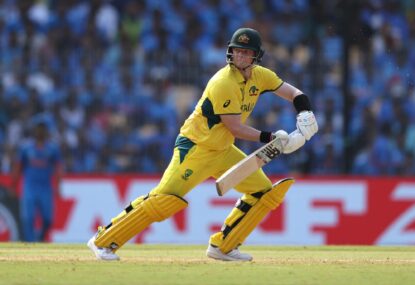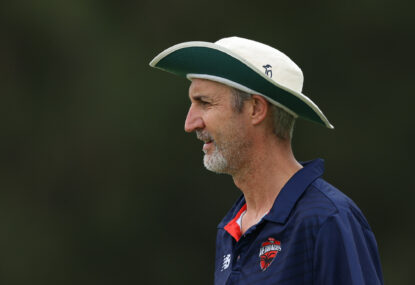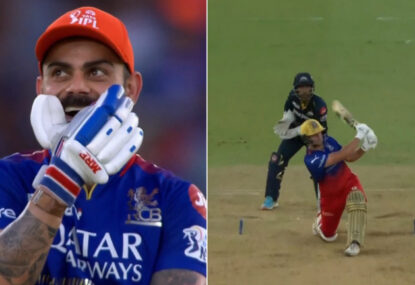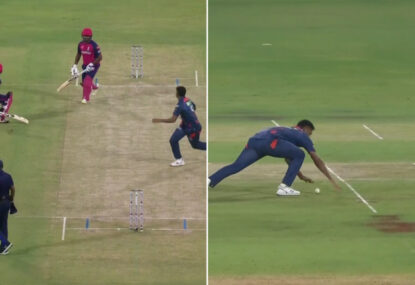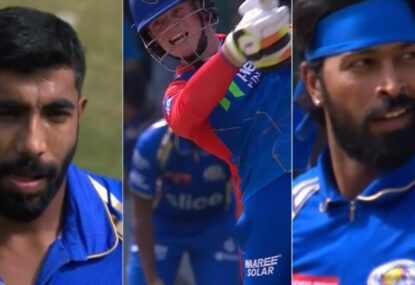Myths are important. They inspire while distilling subconscious insights into the human condition.
They were important when Hercules killed the Minotaur and they remain so now, when lesser myths take shape on the sporting field.
The Australian men’s Test cricket team and its feats spanning lifetimes was one such modern day myth, believed by myself and millions more cricket lovers around Australia.
Chinks in the mythology had appeared earlier – the callous way Australian players often treated their opponents.
Shane Warne and Mark Waugh’s ill-conceived dalliance with John the bookmaker; Shane Warne’s suspension for use of a diuretic, and Simon Katich’s unjust removal from the Test team at the behest of Michael Clarke.
However, we always comforted ourselves with the notion that the sheer weight of our winning glossed over or even justified those misdeeds. And, more pertinently, that however close we went to the line, we never cheated.
That the line was vague and adjusted according to our own behaviour was ignored. The myth was finally shattered in Cape Town on 24 March 2018, when the Australian captain, vice captain and a junior player engaged in brazen and poorly executed cheating.
That this occurred under the leadership of Steve Smith, the Australian that had come closest to reaching the rarefied air of Donald Bradman, the man on whom this myth found its bedrock, was all the more jarring in exposing the myth’s falsehood
The response from Cricket Australia was swift and severe when measured against the ball-tampering scandals of other nations, but this wasn’t a result of higher standards in Australian cricket.
It was the act of a psychically wounded nation lashing out in vain to protect one of its founding myths.
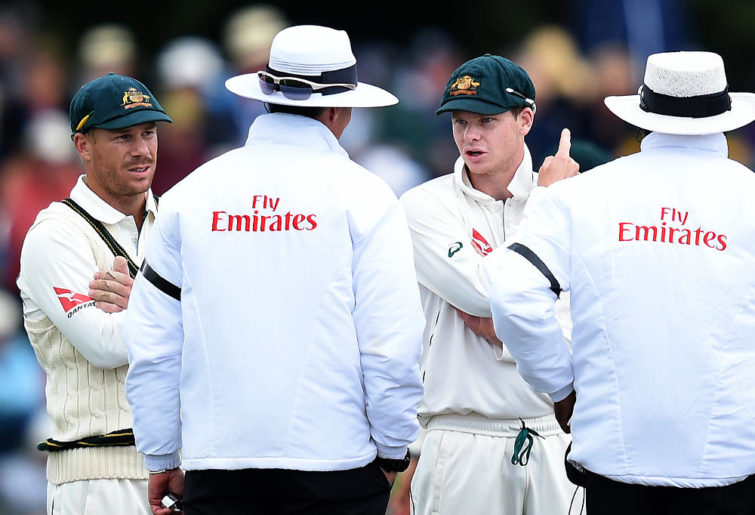
Australian captain Steve Smith chatting to the umpires. (AAP Image/Dave Hunt)
In the time since, Australian cricket has undergone a cultural reckoning, coinciding with two new broadcasters in 7 and Foxtel, who have been decidedly less blokey in their coverage than 9, emphasising the sense that a sea change in Australian cricket is at hand.
Pat Cummins has emerged as a future captain in the leadership void left by Smith and David Warner and the instinct driving desire for Cummins’ leadership is a focus on integrity, as opposed to exceptional talent (which Cummins possesses in spades), in determining who ascends to leadership.
It is also driven by the too-late realisation that integrity and principles supersede in value the more transient concept of winning.
There is always another contest to be fought and won; the way those contests should be fought – with fairness, honesty and tenacity – is a constant.
Whether the Australian team has absorbed these lessons will be on full display at the World Cup in England.
The potential for redemption is obvious and enticing, with so much resting on Smith’s and Warner’s ability to return to the team with humility and not disrupt the changes in playing style witnessed in home Test series and recent ODIs in India.
Any sense that Smith’s return is curtailing Aaron Finch’s ability to lead the side could prove fatal to Australia’s chances of lifting the trophy.
This year’s World Cup features three competing narratives among the sides best placed to win, Australia, India and England.
For the first time, England seems to have figured out the shorter form of the game, and with the tournament on home soil are well placed to conquer the world.
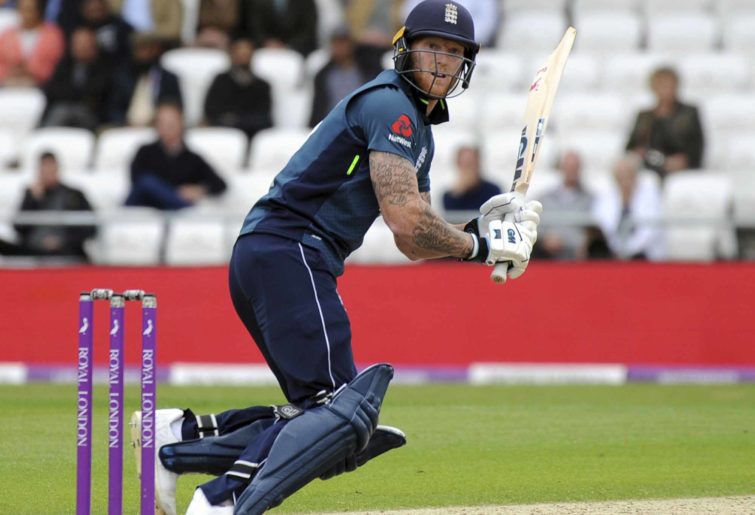
Is England favourite for the World Cup? (AP Photo/Rui Vieira)
They have promised so much previously and failed to deliver, so the ability to remain composed within games will be their biggest obstacle.
England’s trump card is Jason Roy, who is able to take the game away from any attack in less than 10 overs, ensuring fields are set back for Joe Root and Ben Stokes to take advantage of.
India’s claim may be the most compelling.
Unlike Australia’s and England’s tales of redemption, India’s is one of destiny. Ruthlessly led by Virat Kohli, with an attack of exceptional variety, India is looking to cement itself as the new and sole power in cricket, supplanting the old guard in Australia and England.
They have wrested financial and administrative control of the ICC via sheer size and the phenomenal success of the Indian Premier League.
The last piece of the puzzle is to replace Australia as the dominant nation on-field, and what better setting to achieve it than in England, the scene of cricket’s birth and a country that once colonised India.
India’s ace is clearly Kohli, arguably the greatest one day batsman ever, combining Ricky Ponting’s brutal disdain for bowlers with Michael Bevan’s masterful pacing in run chases.
In Kohli’s captaincy, India has an amalgam of Sourav Ganguly’s savvy and Sachin Tendulkar’s imperiousness. Neither of those two were able to drag India to the top and keep them there but Kohli appears destined to do so.
Australia’s claim on the other hand, at least narratively, is the most tantalising. It involves redemption at the personal, team and national level, and would signal that Australian cricket has learned the lessons of its failures.
It would be akin to the ageing heavyweight boxer summoning every ounce of remaining grit to defend his title one last time.
There hasn’t been a scandal involving a Test captain as significant as the sandpaper fiasco since Bodyline and it would be remarkable if Australia could shake off its effects so quickly. With respect to Hansie Cronje and South African cricket, he wasn’t half the player Smith is and South Africa is a lesser cricketing nation than Australia in every measurable way.
If Australia were to salute at this year’s World Cup, having performed poorly in ODIs for much of the last three years and having suffered (rightly) the ignominy of a cheating scandal, it will signal once and for all that Australia’s place atop cricket is untouchable. It would be a comeback to make ScoMo proud.
Australia’s key is not a batsman, although he wields the blade more than handily, but the captain-in-waiting alluded to earlier, Cummins, who, like Kohli, has the uncanny ability to sense and seize the moment. The trajectory of his career – finally fit and locked in as Australia’s spearhead – has him primed to deliver a record sixth World Cup in the vein of Mitchell Starc in 2015.

Pat Cummins takes a wicket. (Photo by Robert Cianflone/Getty Images)
Top to bottom, Australia’s line up is the most talented in one day cricket, but there is also more that could go wrong than for England or India.
I would start with Aaron Finch, Usman Khawaja, David Warner, Steve Smith, Glenn Maxwell, Shaun Marsh, Alex Carey, Cummins, Starc, Adam Zampa and Jason Behrendorff.
Smith and Warner haven’t played international cricket in over a year and may not have time to hit top form. Each of Finch, Khawaja, Maxwell and Marsh is prone to horrible form slumps, however Khawaja and Marsh are far more reliable in 50-over cricket than over five days.
If Maxwell or Marsh proves shaky they’re likely to be replaced by Marcus Stoinis, who is even less a sure thing than they are. Carey is nowhere near proven at international level and is the biggest liability in the side.
The loss of Richardson is a heavy blow as he demonstrated the rare ability to swing the ball both ways with extreme pace and precision.
Starc has been lacklustre for the last year but there is a huge opportunity for him to re-establish his dominance in the format he’s best suited to.
Australia can’t win the World Cup without at least one of the quicks supporting Cummins and given the inexperience of Behrendorff and Coulter-Nile at international level, the onus is on Starc to deliver.
However, the main competitors in India and England are too explosive at the top of the order and pace alone will not suffice.
Zampa is a steady, albeit unspectacular, leg spinner who has had some success in recent times, but he doesn’t do a lot with the ball and could be exposed on English pitches, which are not usually conducive to legspin unless you are a certain blonde, Hawaiian pizza-loving Victorian.
The key for Zampa will be to bowl within himself, focusing on control to tie down the batsman and speed through the middle overs.
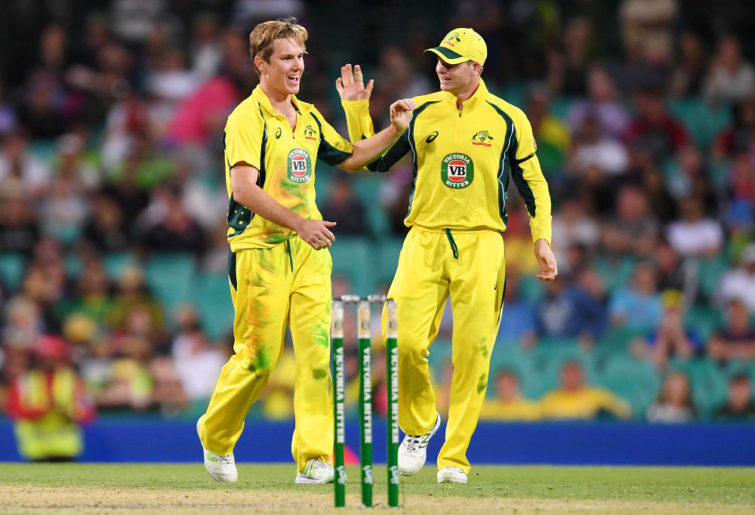
Adam Zampa celebrates with Steve Smith. (AAP Image/Paul Miller)
All that said, the batting is explosive and the bowling is stacked with pace. No country has a batting duo to match the quality of Warner and Smith or Australia’s proven record of producing its best cricket at World Cups.
The lesson of Australian cricket’s last 20 years is that it is dangerous to make mythical heroes out of human beings, who are just as fallible as anyone else, and that putting them on a pedestal with obsessive fawning may actually contribute to declining standards.
If Smith and Warner are able to contribute to a World Cup win with a new, less abrasive, but equally competitive Australia, they may become something much more inspiring than any myth: human beings who have accepted their punishment quietly and learned from their mistakes. And that is something we can all aspire to.



































































































